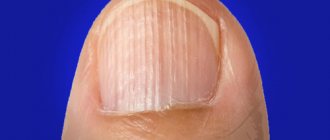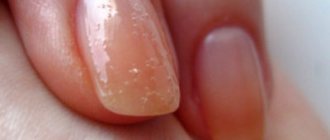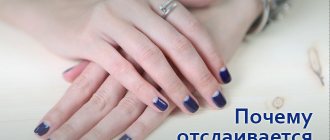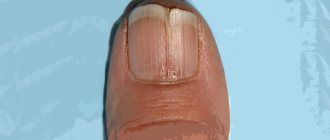Nails, like hair, are called appendages of the skin. In humans, they have lost their original protective function, but they have not lost the ability to reflect the state of the body. And a change in their appearance - fading, thickening or, conversely, thinning, as well as a change in color, indicates health problems. This may indicate both pathology in some organ and diseases of the nail plates themselves.
Today we’ll talk about why the fingernails of women and men turn yellow – when you should be afraid of it, and when you can limit yourself to a few local events to get them in order.
What healthy nails should look like
The nail plate should be uniformly pink, with only 2 white areas: a small crescent (lunula) at the base of the nail and the free edge. There should be no other white zones, as well as areas of a different color, on this keratinized appendage of the skin.
The nail plate has a shape close to ovoid (like an egg). If it acquires pronounced roundness and convexity, resembling watch glasses, this indicates conditions in which the tissues do not receive enough oxygen. This happens with diseases of the heart, lungs, bronchi and liver that occur chronically (for example, with heart defects, chronic bronchitis and others).
The cells that give rise to the nail are called the matrix. They are responsible for the shape, density, thickness and growth rate of the nail plate. The length and thickness of the matrix itself are determined genetically. The shorter it is, the thinner the nail plate, and this cannot be changed. But if the nail becomes thinner over time, this indicates that the growth zone is affected by a disease, which, by eliminating it, can improve the condition of the nail plate.
The matrix is located below the lunula and is covered with two layers of skin. Damage to it causes the nail to stop growing. Under the visible part of the nail there is a zone where matrix cells differentiate. It is rich in blood vessels, which is why it has a pink color.
If there are only a few layers of keratinized cells in the skin itself, then the nail plate is solid keratinized cells lying like tiles on a roof. This makes the nail permeable to moisture, which is absorbed and released here 100 times more intensely than in the skin, accounting for 12-15% of all exuded fluid. Varnishes and creams applied to nails can pass through the keratinized cells of the plate and land on the epithelium of the nail bed.
When the reason is the chemical composition of the nail coating
Often, nails turn yellow after varnish that contained a coloring pigment that was absorbed by the porous structure of the nail plate. But its color can also be affected by harmful substances contained in coatings (especially cheap ones). This:
- formaldehyde resin (formalin). Formalin itself is a carcinogen used to embalm dead animals;
- dibutyl phthalate (DBP), which is added to varnishes to protect them from chipping; may cause cancer;
- toluene: the more of this substance, the more “smooth” and “easy” it is applied. Leads to liver dysfunction;
- camphor oil: it gives greater plasticity to the varnish and improves its “adhesion” to the nail plate. In addition, camphor is a powerful allergen and toxic substance for the liver.
Varnishes containing these substances have a toxic effect on the liver, which is why these skin appendages turn yellow. Perhaps this is not from the first use, but after prolonged use with frequent “renewal” of the nail coating. You can eliminate this effect by carefully choosing varnishes (you need those that say “Big 5 free” or at least “Big 3 free”). In addition, even the most ordinary varnish must be applied not directly to the nail, but onto a varnish base. This substance will, like a sponge, absorb natural fluid that is removed from the body through the skin appendages: after all, if the effusion penetrates the coloring pigments of the coating, it will help them “absorb” into the nail plate.
A situation often arises when the gel on the nails turns yellow. The reasons for this may be the following:
- The presence of nitrocellulose in the varnish, and not its synthetic substitute - CBA. Being a product of mixing cotton or wood fibers with aggressive acid - sulfuric or nitric, it is necessary to obtain a bright glossy film on the nails. But when it gets on the nail plate, nitrocellulose will be very fragile and will move away from its surface as soon as it once again (this happens all the time) changes the shape of its curvature. To prevent this from happening, plasticizers - dibenzoates - are added to the varnish. During prolonged wear, which is typical for gel polishes (they were invented for this purpose), this composition leads to yellowing of the varnish. Therefore, before purchasing or applying shellac in a salon, ask about its composition: it should say “CBA” and not “Nitrocellulose”
- The components of tobacco smoke (nicotine and tar) can also turn the varnish, gel or skin appendages themselves yellow. In this case, you may notice that the nail on 1 or several fingers of the hand—the one holding the cigarette—has turned yellow. The nails of the second hand and toes did not change color.
- Exposure to sunscreens combined with solarium tanning. This “complex” can change the light color of acrylic or gel polish to yellowish, iodine yellow, and even brown.
- Components of household chemicals can change the color of the applied coating. Please note, maybe you clean the bathtub with Comet powder or wash the stove with another product without wearing gloves? Nail service professionals claim that a reaction between the components of even the most expensive coating and ingredients from household chemicals without gloves is inevitable.
- We can assume that the nails have turned yellow from the varnish, but in fact, after applying it, the woman is actively in contact with various chemical compounds not from household chemicals. Thus, the most common complaint is that the yellowness appeared after peeling carrots or preparing homemade preserves.
Acrylic can also turn yellow if:
- it itself is not of high quality - it contains few substances that suppress the effect of ultraviolet radiation on the color of the coating;
- the woman herself removes the top gel layer after a while, covering the nail with colorless varnish;
- cover acrylic immediately with a topcoat, without gel;
- use a topcoat without a sticky layer.
Whatever the reason, if the nails turn yellow after varnish, and not due to any diseases, this is characterized by the following signs:
- Varnish/gel polish of bright colors was used;
- the color changed only on those nails that were painted in this tone;
- you do not take any pills all the time;
- the yellowing did not appear after visiting the pool, wearing someone else's shoes or using someone else's towel;
- the state of health has not changed;
- the hands have a normal color, and if you move the lower eyelid in front of the mirror and look at the whites of the eyes, they do not turn yellow.
Cosmetical tools
Brigitte Bottier, Repairing Polish for Yellow Nails
A transparent varnish for masking yellowness, which applies as a thin film. Due to the presence of algae extract, calcium and vitamin E, it takes care of nails, normalizes air exchange and eliminates yellowness if it is not caused by internal reasons.
Essence, Whitening polish
The brightening effect is achieved by including natural lemon extract in the composition. Can be used as a base coat for cosmetic varnish, in this case it also acts as a product that protects the nail plate from pigmentation.
Frenchi Smart Enamel Nail Whitener
The active bleaching agent is lime extract. Contains a UV filter to prevent the penetration of ultraviolet rays. Apply in 2 layers as a stand-alone product and in 1 as a base for colored varnish.
Orly, Nail Whitener
Dissolve the bleach in water and then soak in the bath for 5 minutes. Contains citric acid and tea tree oil. After the bath, it is recommended to apply a base coat or clear varnish to prolong the effect of the drug.
External causes or temporary yellowing
When your nails turn yellow, the reason may be:
- Taking certain medications for a long time. This effect can occur due to the use of Ciprofloxacin, Norfloxacin, Gatifloxacin, Doxycycline, Tetracycline, Aminarsone, Sodium Arsenate, Duplex, Novarsenol.
- Smoking - in this case, the nails on one hand turn yellow, usually on the thumb, index and middle fingers. The fingers below these nails also turn yellow, acquiring a specific smell.
- If only your fingernails have turned yellow, remember what new household chemicals you started using. These can be cleaning pastes and powders, glass cleaning sprays.
- Nail polish remover containing acetone can cause yellow nails. In this case, the nail plates of the changed color will not be everywhere, but only where the woman often removes the polish.
- Drinking large amounts of tea or coffee. Both of these drinks contain a pigment that has a coloring effect on the skin, teeth and nails.
- Collecting or cleaning walnuts whose green shells and leaves contain iodine. In small quantities it stains nails and fingers yellow, in large quantities – brownish-black.
Dealing with yellowness in this case is simple - you need to eliminate the influence of the above chemical compounds (for example, stop smoking or use household chemicals with gloves). In order not to wait until the nail plates are completely renewed (this will take 96-115 days), you can use folk remedies or cosmetics, which we will describe at the end of the article.
Preventive measures
- When performing a traditional manicure procedure, you must always follow simple hygiene rules. And before applying decorative varnish, use a base.
- Periodically use antifungal creams and healing baths.
- If you still smoke, you should get rid of this habit. It is better to enjoy dark chocolate and your favorite fruits.
- Of course, it’s simply impossible to create your favorite manicure without polish, but don’t forget about the health of your nails by leaving them unpainted every four days.
It should be noted that even nail experts recommend not to overload your nails with decorative products and not to paint your nails at all for at least a few days a month. After all, this is the only way the nail plate can breathe freely and recover naturally.
- In addition to these recommendations, do not forget to wear special gloves when cleaning.
As a result, we can safely say that if your nails have acquired a yellowish tint, you should not be upset. After all, thanks to simple treatment methods, you can quickly get rid of this non-aesthetic ailment, and following simple preventive measures will help you never encounter yellow marigolds.
When yellow nails are a sign of illness
Yellow toenails or fingernails may indicate illness. These can be both pathologies of the whole body and diseases specifically of the nails.
Onychogryphosis
This is the name of a hereditary change in the nail shape when the nail becomes:
- dirty yellow color;
- hard;
- dull;
- acquired a curved shape;
- rose up and became thicker.
Either one or several nails can be damaged, becoming similar to the claws of a bird. Only the little toes may be affected.
Acquired onychodystrophy
This is the name of the condition when the blood supply to the nail plates is disrupted. It occurs as a result of a number of diseases:
- pneumonia;
- scarlet fever;
- measles;
- dysentery;
- typhus and typhoid fever;
- varicose veins;
- atherosclerotic lesions of blood vessels in the arms or legs;
- syphilis;
- various neuritis;
- multiple sclerosis;
- hypovitaminosis: mainly with hypovitaminosis A and pellagra - deficiency of vitamin PP and proteins (vitamin C deficiency is manifested by bruises under the nail plates and their detachment).
In the last five cases, onychia can act as the only symptom, so when making such a diagnosis, an examination is necessary to determine its causes.
Dystrophic onychias are described as “the toenails turned yellow” or “the fingernails turned yellow.”
This diagnosis is considered if:
- the nails have turned yellow and are moving away, and they are moving away from the free edge towards the lunula;
- became dull;
- acquired a yellowish-gray color;
- arcuate transverse stripes and pinpoint impressions appear on top;
- their fragility has increased;
- the plates are split longitudinally, starting from the free edge.
If similar symptoms are observed on one finger (for example, the big toenail turns yellow), this indicates trauma to the nail bed - for example, from uncomfortable shoes, from an impact, or from a manicure/pedicure.
Psoriasis
This skin disease does not always begin with a skin lesion - a shortening of the development cycle of skin cells and the layering of a large number of them can also begin with the nails.
Characteristics:
- clouding of the nail plate;
- the appearance of depressions and grooves on the nails, which makes it look like a thimble;
- without any redness in the area of the lateral ridges of the skin, the nail peels off - all or part of it;
- Until the nail plate falls off, dirt gets into the space between it and the skin, and epithelial particles accumulate. Because of this, it seems that the nail has acquired an off-white color;
- after a while, hemorrhages appear under the affected nails - spots of pink, reddish, burgundy or black;
- at the final stage of the disease, the nails are cloudy, rough, flat or even concave, and dirty yellow.
Fungal nail infection
If your toenail turns yellow, but you didn’t rub your toe, didn’t hit it, no one stepped on it, and you didn’t use new polish or acetone, it could be a fungal infection of the nail (onychomycosis). In most cases, the cause of the disease is the fungus Trichophyton, Epidermophyton, Microsporium. 20-40% of the pathology is due to aspergillus, fusarium and scopular mycosis. Candida, which causes thrush, can also cause yellowing of the nail plate on the big toe.
The fungus rarely affects only the nail, causing inflammation. It often spreads from infected toes and heels. The pathogen can be carried through the bloodstream from an area of inflammation (for example, from the lungs). People who suffer from diabetes, receive chemotherapy or radiation treatment, or take glucocorticoid hormones to maintain a decent quality of life with systemic diseases are more likely to “bring” mycosis from a public pool or shower.
Mycosis usually begins on the big toes or little fingers; The hands are less commonly affected. Symptoms vary depending on the type of pathogen and the state of your own immunity. There are 3 forms of damage to the nail plates:
- Hypertrophic. It is distinguished by the fact that the nail has become thick and yellowish. Its surface remains smooth for a long time, then peels off, loses its characteristic shine, and acquires jagged edges.
- Normotrophic. At the same time, yellowish and whitish zones appear in the thickness of the nail plate, but the nail itself does not thicken or peel off; its shape remains unchanged.
- Atrophic. The nail plate becomes thinner, peels off from the underlying skin, and may collapse.
Home Remedies
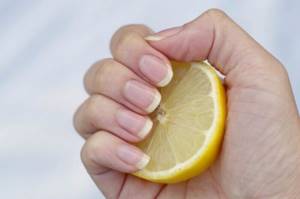
To whiten nails at home, use baths, masks and lotions based on:
- lemon and citric acid;
- toothpaste;
- hydrogen peroxide;
- vinegar;
- soda;
- essential oils.
Baking soda
You can use soda in two formats - as an independent product or as one of the components of the bath.
- for a bath - add 1 tsp to 1 liter of warm water. soda and lower the brushes for 10-15 minutes. The bath has a whitening effect and also strengthens nails. Monitor the temperature of the liquid - it should not be too cold, but not scalding - from 37° to 40°C.
- To whiten with soda, take a soft brush, for example, an unnecessary toothbrush, moisten it with water and pick up a small amount of soda. Gently brush the nail plate for no longer than 30 seconds per nail. After completing the procedure, wash off the remaining soda with warm water and lubricate your hands with cream.
Baking soda can be used once a week for as long as necessary until complete whitening occurs.
Lemon lotion
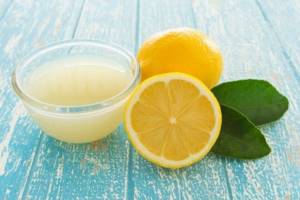
- Squeeze the juice from half a lemon;
- Soak a cotton pad with the juice and rub the juice into each nail;
- Leave for 15 minutes. then add warm water.
Do not use lemon juice if you have inflamed hangnails, wounds or abrasions - lemon juice irritates the skin and causes discomfort.
Toothpaste mask
- 1 tsp. Mix whitening toothpaste with 1 tsp. baking soda and stir;
- Apply the resulting mixture to your nails and leave for 15 minutes;
- Rinse off any residue by rubbing or using a soft brush.
Express mask with peroxide
- Mix hydrogen peroxide with water in a ratio of 1 to 2 - per 1 tsp. peroxide, 2 tsp. water;
- Add 2 tsp. toothpaste and wait until it stops foaming;
- Apply the mixture for 1-2 minutes, then rinse with warm water using massaging movements.
Vinegar bath
- In 1 l. add 1 tbsp warm water. l. vinegar 70%;
- Immerse your fingertips in the bath for 10-15 minutes;
- Rinse your hands well under warm running water, wipe dry and apply cream.
Hand baths: 30 recipes for different purposes
Salt bath
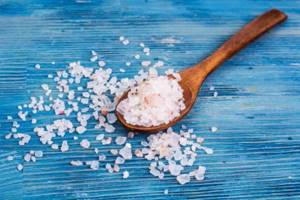
- Dissolve 1 tbsp in 1 liter of water. l. sea salt;
- Add 2-3 drops of tea tree oil to the bath and soak the brushes for 10 minutes;
- Rinse off the remaining salt, then moisturize the skin with cream.
Mask with oils
- 1 tbsp. l. Mix lemon with ylang-ylang and jojoba oil. 1-2 drops of each oil will be enough;
- Apply the mixture to your nails with a cotton pad and leave for 5-7 minutes;
- There is no need to rinse off the composition - just wipe your fingertips with a dry cloth.
All these recipes only mask the problem, but do not treat the cause if it lies in a disease or other pathology. The disappearance of yellowness does not always indicate recovery, so try to maintain your health and get checked regularly.
A guide to diseases and problems with nails: diagnosis, causes and remedies for 12 diseases
If the yellowness is located under the nail plates
If it turns yellow under the nails, this most likely indicates a pathology of one of the internal organs. It could be:
- Jaundice, the causes of which are diseases: liver (hepatitis, cirrhosis, liver cancer or metastases to this organ),
- biliary tract (cholelithiasis, tumor of the papilla of Vater),
- vessels supplying the bile ducts and liver
- erythrocytes, in which their increased breakdown occurs in the vessels.
This group of diseases is characterized by yellowing of the skin, the appearance of yellow coloration of the sclera, drowsiness, nausea, there may be bitterness in the mouth (if the cause is in the bile ducts), loss of appetite, and changes in the color of feces and urine.
Prevention
If the cause of the disease is injury or an infectious disease, then it is impossible to prevent the occurrence of a fungal infection. Otherwise, by adhering to simple rules , you can protect yourself from the occurrence of unpleasant diseases and their consequences:
- You must follow the rules for visiting swimming pools, saunas or fitness centers.
- Before a manicure or pedicure, you must disinfect your instruments.
- Chronic diseases should not be allowed; they can cause yellowing of nails.
How to determine the cause of yellowing nails
To make a diagnosis, a comprehensive examination is required:
- Examination by a dermatologist with examination of the nail plates under a microscope and inoculation of their areas on nutrient media (this will help determine the type of fungus and its sensitivity to antifungal drugs).
- Blood test for glucose levels.
- Analysis of venous blood for liver tests.
- X-ray of the lungs - if there is a suspicion of tuberculosis, pneumonia or tumor damage to the lung tissue.
- Blood lipidogram (determining the amount of fat fractions, including cholesterol).
- Determination of the amount of thyroid hormones - if diseases of this organ are suspected.
- Blood for RW - if there is a suspicion of latent syphilis.
- MRI of the brain - to identify multiple sclerosis, as well as the causes of acromegaly.
Drug treatment
If the cause is nail fungus
To get rid of fungal nail infections, use special fungicidal varnishes and liquid products intended for treating the nail plate:
- Batrafen varnish, which contains ciclopirox, which fights fungus;
- varnish Loceryl (active ingredient – amorolfine);
- Demicten varnish (attention: it contains poisonous formic aldehyde, but it does not pose a danger for local, limited use);
- medicinal liquid Exoderil (active ingredient - naftifine).
Which product should you choose and which one is more effective in fighting fungus? It should be remembered that all appointments are made by the doctor. And the patient’s task is to use the drug, following the instructions, and adhere to the recommendations regarding secondary prevention. It is necessary to be patient (the treatment is long!) and not to skip treatment procedures. Only in this case will victory over the fungus be guaranteed.
If the cause is common diseases
If a person’s fingernails have turned yellow due to the presence of some internal disease, it is recommended to undergo an examination and consult with a therapist, dermatologist, infectious disease specialist, or endocrinologist. After receiving the test results, the doctor will prescribe a course of treatment.
Advice: do not mask the yellowness of the nail plates. Colored varnishes can only aggravate the problem. In this case, correctly prescribed therapy for the underlying disease will help.






